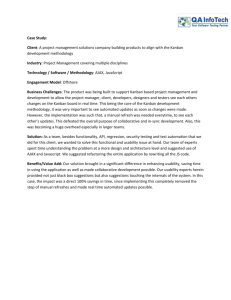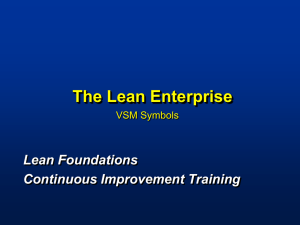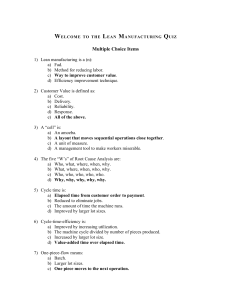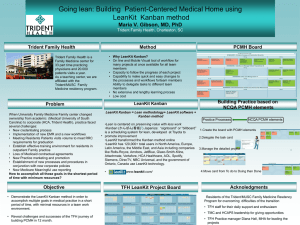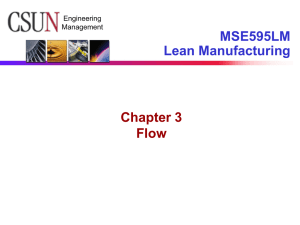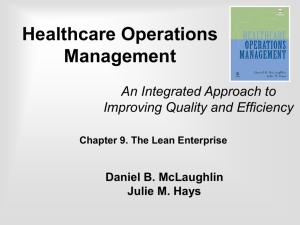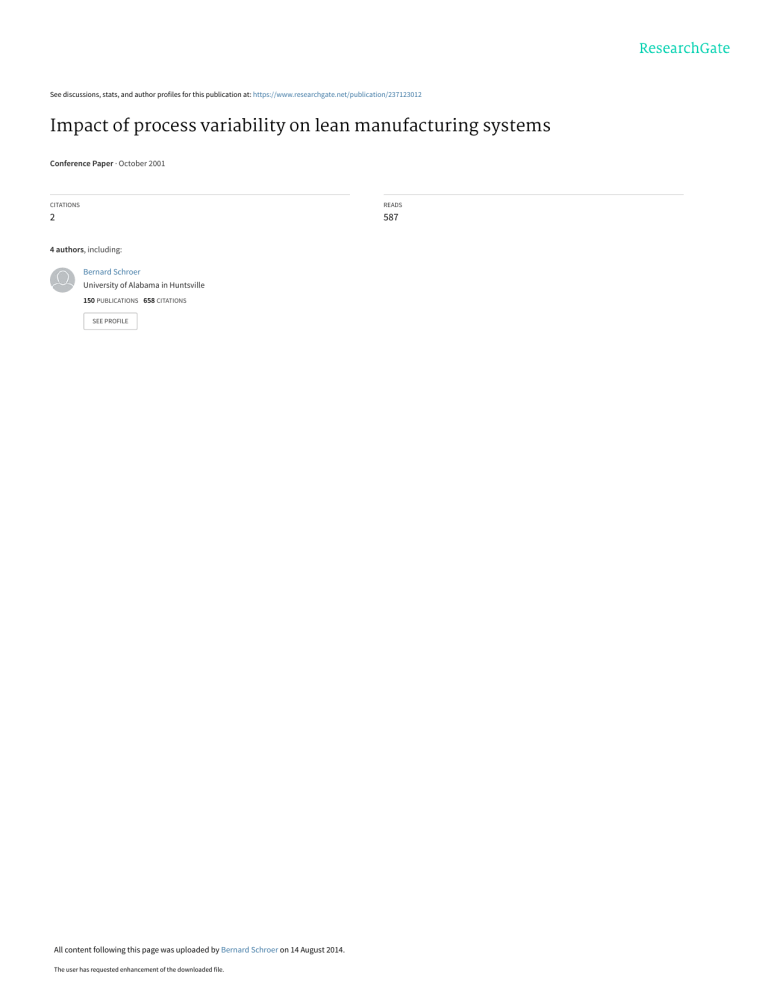
See discussions, stats, and author profiles for this publication at: https://www.researchgate.net/publication/237123012 Impact of process variability on lean manufacturing systems Conference Paper · October 2001 CITATIONS READS 2 587 4 authors, including: Bernard Schroer University of Alabama in Huntsville 150 PUBLICATIONS 658 CITATIONS SEE PROFILE All content following this page was uploaded by Bernard Schroer on 14 August 2014. The user has requested enhancement of the downloaded file. IMPACT OF PROCESS VARIABILITY ON LEAN MANUFACTURING SYSTEMS Mel Adams and Bernard J. Schroer Center for Automation & Robotics University of Alabama in Huntsville Huntsville, AL 35899 adamsm@email.uah.edu Larry R. Gunter and Bradley J. Schroer U.S. Army Aviation and Missile Command Redstone Arsenal, AL Lean Manufacturing Cycle time Kanban ProcessModel ABSTRACT This paper presents the impact of process variability on production and station/operator utilization in a manufacturing plant. Process variability is evaluated in terms of cycle time variance, Kanban capacities between manufacturing stations and mean cycle times. A simulation model was written in ProcessModel of the manufacturing line that was used to analyze process variability. INTRODUCTION Lean manufacturing is a systematic approach to identifying and eliminating waste (all non-valueadded activities) through continuous improvement by flowing the product at the pull of the customer in pursuit of perfection (NIST MEP 1998). Competition is forcing manufacturers to improve quality, reduce delivery time and lower cost. The essence of lean is to compress time from the receipt of an order all the way through to payment. The results of compressing time are greater productivity, shorter delivery times, lower costs, improved quality and increased customer satisfaction. The key to lean manufacturing is to compress time by eliminating waste and thus continually improving the process. The more common lean manufacturing tools are value stream mapping, work place organization (5 S’s), seven wastes, standardized work, visuals, plant layout, quality at source, batch reduction, teams, pull/Kanban, point-of-use storage, quick changeover, one piece flow, cellular, and Takt time (NIST, 1998). A number of books have been written describing these tools (Greif, 1991; Imai, 1986; Nakajima, 1988; Ohno, 1988; Rother and Shook, 1999; Shingo, 1983; Shingo, 1986; Shingo, 1989, Sekine, 1990; and UAH, 2000). Teams of operators and managers use these tools in a lean system to reduce complexity, link operations, standardize work methods, enable mixed model lines and level production. However, this last strategy, even under the best circumstances, is often difficult to achieve. The focus of this paper is on this last strategy. Takt time is defined as “available time per time period/customer demand per time period.” For example, if the available time is four hours and customer demand is 1,440 units, then Takt time is 14,400 sec/1,440 units or 10 seconds. Therefore, no operation can exceed 10 seconds to meet customer demand. If it does, then ways must be found to improve the operation, reallocate work or improve the method. An important element of lean manufacturing is the reduction of variability in all processes. Process variability significantly affects production throughput, delivery, quality, costs and customer satisfaction. There is considerable interest in understanding the factors that contribute to process variability and the significance of these factors. Simulation is an excellent tool to study process variability in a controlled environment. MANUFACTURING LINE The lean manufacturing line for this study is from Round 4 of the electronics assembly simulation which is a hands-on lean manufacturing training simulation of a factory that manufactures a simple electronics device (NIST, 1998). A typical eight-hour game consists of four rounds, or shifts, of twenty minutes each. Customer demand is set at 120 units per shift. In Round 1 the participants are instructed to make as much product as possible in twenty minutes. In Rounds 2 and 3 participants make improvements to the manufacturing line and the line run for another twenty minutes each round. Between each round the participants are introduced to lean manufacturing and the continuous improvement process. In Round 4 the participants setup the manufacturing line to operate in a one-pieceflow and pull mode to Takt time. Figure 2 is a layout of only the manufacturing line for Round 4. The line consists of five assembly stations and an inspection station. Those units that fail inspection are routed to a rework station. Units move through the line in a pull mode. For example, Station 3 does not begin assembly until there is a need for a unit at Station 4. A Kanban that controls the number of units between stations triggers this need. If the Kanban level is set at two, then whenever the work-in-process at Station 4 drops to one or less, Station 3 will begin assembling units to replenish the work-in-process. The following parts are placed on the board at each station: Station 1 2 3 4 5 6 Figure 1. Functional layout of manufacturing facility Figure 1 is a functional layout of the company. In summary, the company consists of a sales department that receives customer orders, sends orders to the shipping department and sends orders for boards to the off-site supplier. The shipping department packs and ships finished units to the customer. The supplier fills orders for boards and delivers the boards to the manufacturing line. Blue Model 5 springs 1 red resistor 1 red resistor 1 green resistor 1 LED Inspection Red Model 5 springs 1 red resistor 1 diode 1 diode 1 LED Inspection SIMULATION MODEL A simulation model was developed of the company in Figure 1. The model was written in Process Model (1999) (See Figure 3). The model is a relative simple model with eleven activities and three storages. One operator is fixed at each station. A unique feature of the model is the logic to make the line operate in a pull mode and under the control of Kanban. The Kanban control of manufacturing is modeled using the “Input and Output Queue Capacities” of the station activities. For example, setting these queues to zero would result in no allowed inventory between the stations. CYCLE TIME VARIANCE Initially the model was run using only constant cycle times of 10 seconds. Since a shift was four hours and customer demand was 1,440 units, Takt time was 4 hours x 3,600 seconds/hour / 1,440 units = 10 seconds. Figure 2. Manufacturing line Variability was introduced by changing the cycle times to triangular distributions. The simulation model was run with the following triangular distributions: T(9,10,11), T(8,10,12) and T(7,10,13). Note that the means were constant at 10 seconds. Only the spread of the triangular distribution increased. Kanban capacity of zero, one, two and three. This is anticipated since the theoretical production limit is 1,440. With a cycle time distribution of T(9,10,11) and a Kanban capacity of zero, the production was 1,382. As the Kanban capacity increased to one, the production increased to 1,432/hour. Increasing the Kanban to two had no increase on production. Therefore, with a cycle time distribution of T(9,10,11) the optimum Kanban between stations is one. Figure 4. Production as a function of cycle time Figure 4 is a plot of the production as a function of cycle time variability. With a constant cycle time of ten seconds and a Kanban capacity of zero, the production was 1,440/four-hour shift. With a cycle time distribution of T(9,10,11), the production dropped to 1,382/hour, with a T(8,10,12) the production dropped to 1,326 and with a T(7,10,13) production decreased to 1,277. Similar reductions in production also occurred with various Kanban limits of one and two units between the stations. With cycle times of greater variability and as the Kanban limits between stations increased, the production also increased and slowly approached the theoretical maximum production of 1,440. For example, the ProcessModel was run with a T(7,10,l3) and a Kanban capacity of five. The production was 1,422, an 8% increase in production over the Kanban capacity of two. STATION/OPERATOR UTILIZATION KANBAN CAPACITY Figure 6. Average station utilization as a function of Kanban capacity Figure 5. Production as a function of Kanban capacity Figure 5 is a plot of the production as a function of Kanban capacity of allowable work-in-process between stations. The production was 1,440 with a constant cycle time of ten seconds and a Figure 6 is a plot of the average station utilization as a function of Kanban capacity of between stations. Since an operator was assigned to each station, this utilization is also the average operator utilization. As anticipated, the utilization was 100% with a constant cycle time of ten seconds. As the cycle time variance increased, the average station utilization decreased. For example, with a cycle time distribution of T(9,10,11) and a Kanban capacity of zero, the average station utilization was 95%. As the Kanban capacity increased to one unit, the average station utilization increased to 99% and a Kanban capacity of two increased average station utilization to 99.5%. there was no buildup of units because of an unbalanced line with different mean cycle times. Without the Kanban control WIP would have built up at various locations in the line. MEAN CYCLE TIME CONCLUSIONS In summary, the following conclusions are made: Figure 7. Production as a function of mean cycle time Figure 7 is a plot of the production as a function of the mean cycle time. In the top graph the Kanban was zero and the mean cycle times were ten seconds (with no variance) for all stations except Station 3. The cycle time at Station 3 was changed to eight and then to twelve seconds. As anticipated, when the mean cycle time increased above ten seconds, production decreased. In fact, the theoretical production at Station 3 with a twelve-second-mean time can be computed as 4 hours x 3,600 seconds/hour / 12 seconds at Station 3 = 1,200 units. Likewise, when the mean cycle time at Station 3 decreased to less than ten seconds, there was no change in production. This is also anticipated since the limiting constraint on production is the ten-second mean times at the other stations. In the middle graph the Kanban was two and the cycle time distributions were T(7,10,13) for all stations except Station 3. The cycle time at Station 3 was changed to T(7,8,9) and then to T(10,12,14). In the bottom graph the Kanban was one and the cycle time distributions the same as the middle graph. As anticipated, production remained constant with the eightsecond mean time and decreased with the twelve-second mean time. Another observation is that since the work-inprocess between the stations was set to zero, • The pull production system with Kanban is an excellent method of making only what is needed, when it is needed, with control on the WIP between stations. • With constant Kanban capacities between stations, production decreases as cycle time distribution variability increases. • With constant cycle time distributions, production increases as Kanban capacities increase between stations. • With constant cycle time distributions, average station/operator utilization increases as Kanban capacities increase between stations. • There is a limit to an increase in Kanban capacity where there is very little increase in production. • A decrease in the mean cycle time at a station (below the means of the other stations) will not increase overall production. • An increase in the mean cycle time at any given station (above the means of the other stations) will decrease overall production. • Features in ProcessModel make the modeling of pull with Kanban systems relatively easy. The trick is the use of the settings of the in and out queue capacities for the activities. ACKNOWLEDGEMENTS This research was funded in part by the Alabama Technology Network, the U.S. Department of Commerce’s National Institute of Standards and Technology and Alabama Development Training. Industrial • • REFERENCES • • • • • • (Greif, 1991): The Visual Factory, Productivity Press, Cambridge, MA. (Imai, 1986): Kaizen: The Key to Japanese Competitive Success, Random House, New York. (Nakajima, 1988): Introduction to Total Productive Maintenance, Productivity Press, Portland, OR. (NIST, 1998): Principles of Lean Manufacturing with Live Simulation Users Manual, NIST Manufacturing Extension Partnership, Gaithersburg, MD. (Ohno, 1988): Toyota Production System, Productivity Press, Portland, OR. • • • • (ProcessModel, 1999): Users Manual, ProcessModel Corp., Provo, UT. (Sekine, 1990): One-Piece Flow, Productivity Press, Portland, OR. (Rother and Shook, 1999): Learning to See, The Lean Enterprise Institute, Brookline MA. (Shingo, 1983): Single Minute Exchange of Dies, Productivity Press, Cambridge, MA. (Shingo, 1986): Zero Quality Control: Source Inspection and the Poka Yoke System, Productivity Press, Portland, OR. (Shingo, 1989): A Study of the Toyota Production System, Productivity Press, Portland, OR. (UAH, 2000): Lean Manufacturing Handbook, University of Alabama in Huntsville, Huntsville, AL. Order Arrivals Supplier Sales Shipping Board Inventory Finished Goods Springs Test Shipped Goods LED Rework R Resistor R Resistor or Diode G Resistor or Diode Figure 3. ProcessModel simulation model View publication stats

